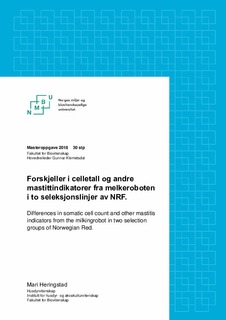Forskjeller i celletall og andre mastittindikatorer fra melkeroboten i to seleksjonslinjer av NRF
Master thesis
Permanent lenke
http://hdl.handle.net/11250/2505777Utgivelsesdato
2018Metadata
Vis full innførselSamlinger
- Master’s theses (BioVit) [348]
Sammendrag
Det kommer store mengder nøye og objektivt registrerte data fra melkeroboter (AMS). Dette er data med stort potensialet til å brukes i avlsarbeidet og som styringsverktøy til bonden. Formålet med denne oppgaven var å undersøke om det var forskjell mellom to grupper av NRF i online celletall (OCC) og i andre mastittindikatorer fra melkeroboten, i nivå og utvikling gjennom laktasjonen. Det var også et mål å undersøke hvor godt konduktivitet
fungerer som mastittindikator, og basert på mønster i celletall hos enkeltkyr vurdere potensialet for nye egenskaper, til bruk i både besetningsstyring og avlsarbeid. Datasettet inneholdt observasjoner fra 173 kyr fra besetningen ved NMBU med til sammen 279 laktasjoner og 99 241 observasjoner totalt. De to gruppene var selektert for høy
melkeproduksjon (høylinjen) og god motstandsevne mot mastitt (frisklinjen) siden 1989. Large amounts of objectively recorded data from milk robots are available and have a great potential for use in breeding and herd management tools. The aim of this study was to investigate whether there were differences between two selection groups of Norwegian Red in online cell count (OCC) and in other mastitis indicators, in level and development through lactation. It was also an aim to investigate how well electric conductivity works as a mastitis
indicator and based on somatic cell count patterns of single cows evaluate the potential for new traits, both for herd management and for breeding. The data set contained observations from 173 cows from the research herd at NMBU with a total of 279 lactations and 99 241 observations. The two groups were selected for high protein yield (HPY) and low clinical mastitis (LCM) since 1989.
